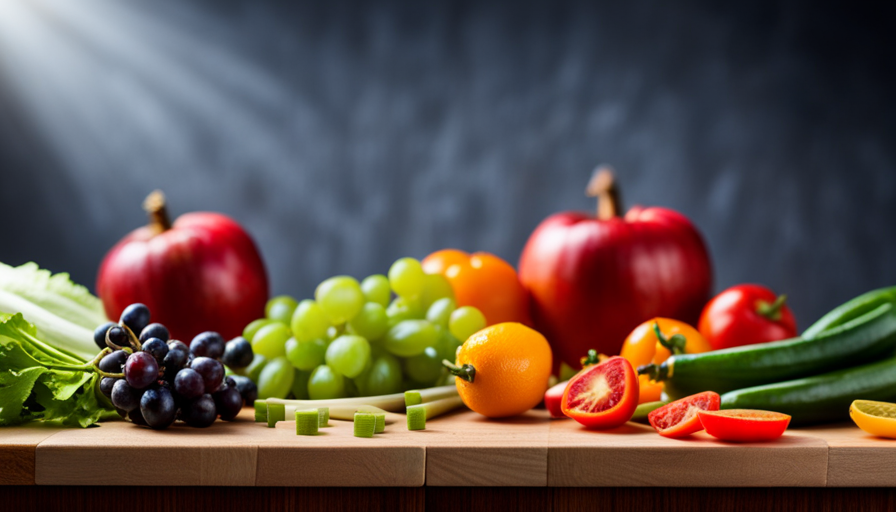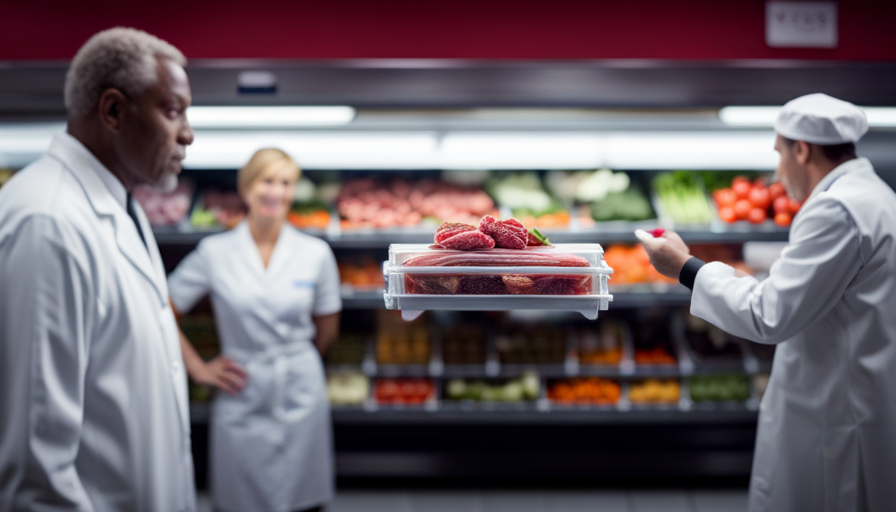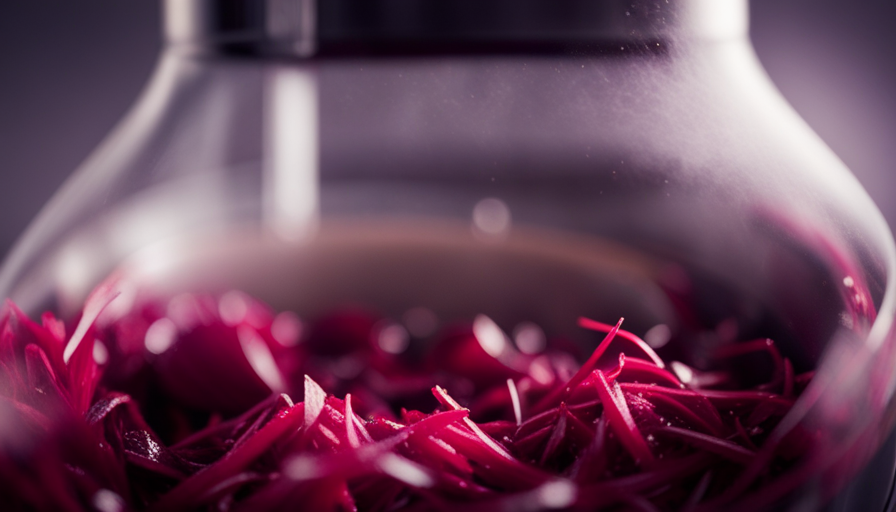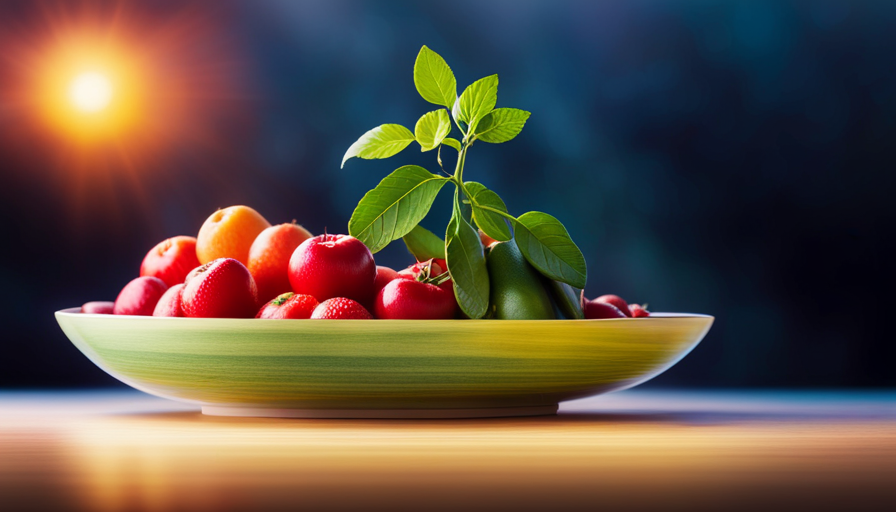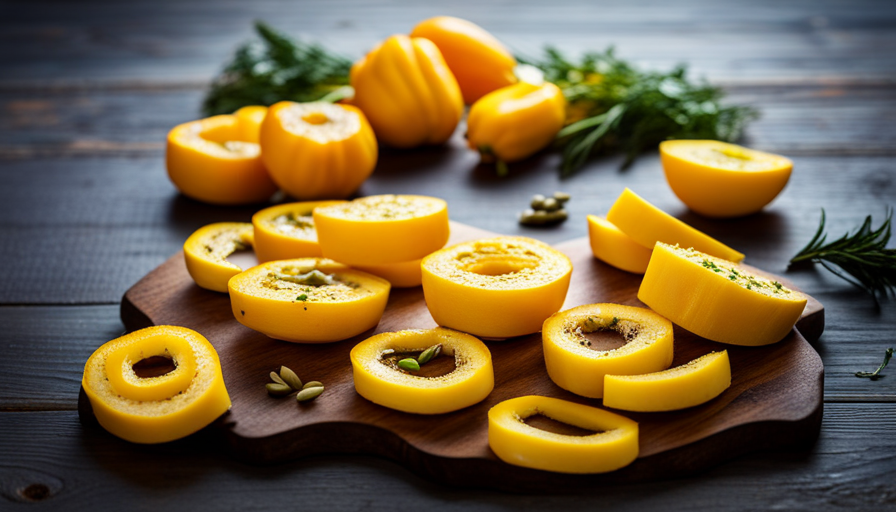I recall the initial time I tasted a juicy, ripe mango right from the tree. The burst of flavors and vivid colors made me feel alive, connected to nature in a manner I had never felt previously. That moment ignited my exploration into the realm of raw food.
If you’re like me, you might be wondering how many calories you need on a raw food diet to maintain your health and vitality. Well, fear not, because I’m here to guide you through the ins and outs of calculating your caloric needs on a raw food diet.
In this article, we will explore the basics of a raw food diet, nutrient-dense raw foods, tracking calorie intake, meeting macronutrient needs, adjusting for physical activity, and consulting with experts.
So, grab a fresh green smoothie and let’s dive into the fascinating world of raw food nutrition!
Key Takeaways
- Calculating caloric needs on a raw food diet involves considering factors such as age, gender, weight, activity level, and goals.
- Nutrient-dense raw foods like leafy greens, berries, nuts and seeds, and avocado can help meet caloric needs on a raw food diet.
- Tracking calorie intake using online tools and apps, as well as keeping a food diary, can help maintain accountability and make necessary adjustments.
- Meeting macronutrient needs, including carbohydrates, proteins, and fats, is essential for energy and bodily functions on a raw food diet.
Understanding the Basics of a Raw Food Diet
If you’re new to a raw food diet, you might be wondering how many calories you’ll need to sustain your energy levels and feel satisfied throughout the day. Understanding the basics of a raw food diet can help you determine your caloric requirements and the benefits it offers.
Raw food diets emphasize consuming unprocessed, uncooked foods like fruits, vegetables, nuts, and seeds. These foods are rich in vitamins, minerals, and enzymes that can support optimal health. Since raw foods are generally less calorie-dense than cooked foods, you may need to eat larger quantities to meet your caloric needs.
To calculate your caloric needs on a raw food diet, you can use online calculators or consult with a nutritionist. Factors like age, gender, weight, activity level, and goals influence your caloric requirements. It’s essential to ensure you’re consuming enough calories to maintain energy levels and support bodily functions.
In addition to meeting your caloric needs, a raw food diet offers numerous benefits. It can promote weight loss, improve digestion, enhance nutrient absorption, and boost overall health. However, it’s important to approach a raw food diet with caution and ensure you’re getting all the essential nutrients your body needs.
Understanding the basics of a raw food diet and calculating your caloric needs can help you embark on this nutritional journey.
Calculating Your Caloric Needs
To determine the fuel required for my body’s engine, I imagine a delicate balance between the intensity of my activities and the energy it takes to keep my internal fire burning.
When following a raw food diet, calculating my caloric needs becomes essential for maintaining a healthy lifestyle. The first step in calculating my caloric needs is to determine my Basal Metabolic Rate (BMR), which is the number of calories my body needs at rest. There are various online calculators that can help me determine my BMR based on factors such as age, gender, height, and weight.
Once I have my BMR, I can adjust it based on my activity level to calculate my Total Daily Energy Expenditure (TDEE). This takes into account the calories I burn through physical activity. If my goal is weight loss, I can create a caloric deficit by consuming fewer calories than my TDEE. It’s generally recommended to create a deficit of 500-1000 calories per day for a gradual and sustainable weight loss.
Transitioning into the subsequent section about nutrient-dense raw foods, it’s important to remember that the quality of calories is just as crucial as the quantity. Nutrient-dense raw foods provide the necessary vitamins, minerals, and antioxidants that support overall health and well-being.
Nutrient-Dense Raw Foods
Transitioning into the subsequent section, it’s imperative to understand the significance of incorporating nutrient-rich, unprocessed foods into our daily eating habits. When following a raw food diet, it’s important to focus on consuming foods that are packed with essential nutrients.
Here are four examples of nutrient-dense raw foods that can be incorporated into your diet:
-
Leafy greens: Spinach, kale, and Swiss chard are excellent sources of vitamins A, C, and K, as well as minerals like iron and calcium. Adding these greens to your smoothies can provide a nutritional boost.
-
Berries: Blueberries, strawberries, and raspberries are not only delicious but also high in antioxidants, fiber, and vitamin C. They can be enjoyed as a snack or added to your nutrient-dense smoothies.
-
Nuts and seeds: Almonds, walnuts, chia seeds, and flaxseeds are rich in healthy fats, protein, and fiber. They can be used as toppings for salads, blended into smoothies, or enjoyed as a quick and convenient snack.
-
Avocado: This creamy fruit is a great source of healthy fats, potassium, and fiber. It can be used as a base for nutrient-dense smoothies, added to salads, or simply enjoyed on its own.
By incorporating these nutrient-dense foods into your raw food meal planning, you can ensure that you’re getting the essential vitamins, minerals, and antioxidants your body needs.
Next, we’ll explore how to track your calorie intake on a raw food diet.
Tracking Calorie Intake on a Raw Food Diet
When following a raw food diet, it can be helpful to track calorie intake using online tools and apps. These resources allow me to easily input the foods I consume and track the calories, ensuring that I’m meeting my nutritional needs.
Additionally, keeping a food diary helps me stay accountable and make adjustments as needed.
Lastly, measuring portion sizes allows me to accurately track my calorie intake and ensure that I’m consuming the right amount of nutrients for optimal health.
Using online tools and apps
By utilizing online tools and apps, you’ll be amazed at how easily you can track your calorie intake on a raw food diet.
Online resources provide an abundance of information and support for those following a raw food lifestyle. They offer meal planning tools that can help you create balanced and nutritious meals, ensuring you meet your calorie needs. Some apps even allow you to scan barcodes and automatically log the nutritional information of the raw food products you consume.
With just a few taps, you can monitor your calorie intake throughout the day and make adjustments as needed. These tools empower you to take control of your diet and make informed choices.
Moving forward, keeping a food diary will help you further understand your eating habits and make necessary adjustments.
Keeping a food diary
Keeping a food diary allows me to gain a deeper understanding of my eating habits and make necessary adjustments for a healthier lifestyle. By recording everything I eat and drink throughout the day, I can see patterns and identify areas where I need to make changes.
Food journaling has many benefits, such as increasing awareness of portion sizes, tracking nutrient intake, and identifying triggers for emotional eating. It also helps me stay accountable and motivated on my raw food diet journey. I can look back at my entries and see how far I’ve come and celebrate my successes.
In the next section, I’ll discuss how measuring portion sizes can help ensure I’m getting the right amount of calories on a raw food diet.
Measuring portion sizes
To ensure you’re getting the right amount of nourishment, it’s crucial to accurately measure your portion sizes. Measuring accuracy is essential when following a raw food diet to maintain proper portion control. By measuring your food, you can ensure that you’re consuming the appropriate amount of calories and nutrients for your body’s needs.
Use measuring cups and scales to accurately measure your fruits, vegetables, nuts, and seeds. This will help you avoid overeating and ensure that you’re meeting your calorie goals on a raw food diet. Remember, portion sizes can vary depending on the type of food, so it’s important to be mindful of this when measuring.
By measuring your portion sizes accurately, you can stay on track with your raw food diet and meet your macronutrient needs seamlessly.
Meeting Macronutrient Needs on a Raw Food Diet
While following a raw food diet, it’s important to ensure that your macronutrient needs are met. Macronutrients, including carbohydrates, proteins, and fats, are essential for providing energy and supporting various bodily functions. Fortunately, there are plenty of nutrient-dense raw foods that can help you meet these needs.
Carbohydrates are the main source of energy in a raw food diet, and they can be found in abundance in fruits, vegetables, and sprouted grains. These foods not only provide energy but also contain fiber, vitamins, and minerals.
Protein is another crucial macronutrient that can be obtained from nuts, seeds, and legumes. These plant-based sources of protein are not only rich in essential amino acids but also contain healthy fats and fiber.
Incorporating healthy fats into your raw food diet is important for brain function, hormone production, and overall health. Good sources of healthy fats include avocados, nuts, seeds, and cold-pressed oils. These fats are rich in omega-3 and omega-6 fatty acids, which are essential for optimal health.
By focusing on nutrient-dense raw foods, you can easily meet your macronutrient needs on a raw food diet. This will not only provide you with the energy you need but also support your overall health and well-being. Transitioning smoothly into the subsequent section about maintaining optimal health on a raw food diet, it’s important to consider other factors such as micronutrient intake and potential nutritional deficiencies.
Maintaining Optimal Health on a Raw Food Diet
Transition: Now that we’ve discussed meeting macronutrient needs on a raw food diet, let’s explore how to maintain optimal health while following this lifestyle.
Current Subtopic: Maintaining Optimal Health on a Raw Food Diet
When following a raw food diet, it’s essential to ensure that you’re getting all the necessary nutrients to support your overall health. While raw foods are generally nutrient-dense, it’s still important to calculate your caloric needs to ensure you’re consuming enough energy to fuel your body.
To maintain optimal health on a raw food diet, here are four key points to consider:
- Variety: Incorporate a wide range of fruits, vegetables, nuts, and seeds to ensure you’re getting a diverse array of nutrients.
- Nutrient density: Focus on consuming foods that are rich in essential vitamins, minerals, and antioxidants to support your body’s needs.
- Hydration: Stay adequately hydrated by drinking plenty of water and consuming hydrating foods like cucumbers and watermelon.
- Balanced meals: Aim for balanced meals that include a combination of carbohydrates, protein, and healthy fats to meet your nutritional requirements.
By following these guidelines, you can maintain optimal health on a raw food diet. However, it’s important to note that individual caloric needs may vary based on factors such as age, gender, weight, and activity level.
Transition: Now that we’ve covered maintaining optimal health on a raw food diet, let’s explore how to adjust caloric intake for physical activity.
Adjusting Caloric Intake for Physical Activity
One important aspect to consider when engaging in physical activity on a raw food lifestyle is adjusting your caloric intake. Whether your goal is weight loss or muscle gain, it’s crucial to ensure that you’re consuming the right amount of calories to support your activity level and achieve your desired results.
When it comes to weight loss, adjusting your caloric intake is essential. Consuming fewer calories than your body needs can create a calorie deficit, which can lead to weight loss. However, it’s important to do this in a healthy and sustainable way. It’s recommended to consult with a registered dietitian or nutritionist who can help you determine the appropriate caloric intake for your weight loss goals while still ensuring you’re getting all the necessary nutrients from your raw food diet.
On the other hand, if your goal is muscle gain, you may need to adjust your caloric intake to support muscle growth. Consuming more calories than your body needs can create a calorie surplus, which provides the extra energy needed for muscle growth. Again, consulting with a registered dietitian or nutritionist can help you determine the appropriate caloric intake for muscle gain while following a raw food diet.
Adjusting caloric intake is crucial when engaging in physical activity on a raw food diet. Whether you’re aiming for weight loss or muscle gain, consulting with a registered dietitian or nutritionist can provide personalized guidance to help you achieve your goals effectively and safely.
Consulting with a Registered Dietitian or Nutritionist
Consulting with a qualified professional like a registered dietitian or nutritionist can provide invaluable guidance and support on your raw food journey. These experts have the knowledge and experience to help you determine your specific caloric needs and ensure that you are getting all the necessary nutrients on a raw food diet. They can assess your current health status, activity level, and individual goals to create a personalized plan that meets your unique needs.
When consulting with a registered dietitian or nutritionist, they may use a variety of tools and resources to help determine your caloric needs. One common method is the use of a food diary, where you track your daily intake and activity levels. This information can then be analyzed to determine if adjustments need to be made to your caloric intake. Additionally, they may also use specialized software or calculators that take into account your age, gender, weight, height, and activity level to provide a more accurate estimate of your caloric needs.
By working with a registered dietitian or nutritionist, you can ensure that you are meeting your caloric needs while following a raw food diet. They can help you create a balanced meal plan that includes a variety of fruits, vegetables, nuts, and seeds to provide the necessary nutrients for optimal health. They can also provide guidance on portion sizes and meal timing to help you maintain a healthy weight.
Transition: As you establish a solid foundation for your raw food diet with the help of a registered dietitian or nutritionist, it is important to consider the long-term sustainability of this lifestyle.
Long-Term Sustainability of a Raw Food Diet
When considering the long-term sustainability of a raw food diet, there are a few potential challenges and limitations to keep in mind. While raw food can provide many health benefits, it can also be difficult to obtain certain nutrients and may require careful planning and supplementation. Additionally, incorporating cooked or lightly processed foods into a raw food diet can help address some of these challenges and provide a more balanced approach that works for individual needs and preferences.
Potential challenges and limitations
Dealing with potential challenges and limitations on a raw food diet, you might find it surprising that calorie consumption becomes a crucial aspect to consider. While raw foods are generally low in calories, it’s essential to ensure that you’re consuming enough to meet your energy needs. Here are three key challenges and limitations to keep in mind:
-
Quantity: Raw foods tend to be more voluminous than cooked foods, meaning you may need to eat larger portions to obtain the same calories. This can be challenging for those with smaller appetites.
-
Nutrient Density: Raw foods are often nutrient-dense, but they may not provide the same amount of calories as cooked foods. To meet your calorie needs, you may need to consume larger quantities of certain foods or incorporate more calorie-dense options like nuts and seeds.
-
Satiety: Raw foods may not provide the same level of satiety as cooked foods, potentially leading to increased hunger and the temptation to overeat.
Considering these challenges, it’s important to find a balance and listen to your body’s needs. Transitioning to a diet that incorporates cooked or lightly processed foods can help address some of these limitations.
Incorporating cooked or lightly processed foods
To achieve a more balanced and satisfying approach to your nutrition, it’s worth considering incorporating some cooked or lightly processed options into your meals.
While a raw food diet can provide numerous health benefits, there are certain challenges and limitations that may arise. Adding cooked food options to your diet can help address some of these challenges.
Cooked foods are easier to digest, which can improve nutrient absorption and reduce digestive issues. Additionally, lightly processed foods, such as steamed vegetables or baked sweet potatoes, can add variety and texture to your meals. They can also provide a greater range of flavors, making your raw food diet more enjoyable and sustainable in the long term.
Finding a balance that works for you is key to maintaining a healthy and satisfying raw food lifestyle.
Finding a balance that works for you
Striking a balance that suits my individual needs is crucial for maintaining a healthy and fulfilling lifestyle centered around raw food. Finding the right balance on a raw food diet can be challenging, as it requires careful consideration of nutrients and calories. One approach is to incorporate cooked or lightly processed foods into the diet, which can help provide a wider variety of nutrients and flavors. However, it is important to be mindful of the potential loss of certain nutrients through cooking. To help guide this process, I have created a table below that outlines some examples of cooked or lightly processed foods and their potential benefits.
| Food | Benefits |
|---|---|
| Steamed vegetables | Retain more nutrients compared to boiling or frying |
| Raw nuts and seeds | Can be lightly toasted for added flavor and texture |
| Fermented foods | Enhance digestion and provide beneficial probiotics |
Finding the right balance on a raw food diet also involves overcoming challenges such as social situations, cravings, and potential nutrient deficiencies. By listening to my body, paying attention to any cravings or deficiencies, and making adjustments as needed, I can enjoy the journey of exploring different raw food options and finding what works best for me.
Transition: As I continue on my raw food journey, it is important to listen to my body and enjoy the process of discovering new flavors and nourishing my body with wholesome foods.
Listening to Your Body and Enjoying the Journey
Embrace the beauty of listening to your body and let the journey of a raw food diet be a delicious and fulfilling experience. When it comes to eating on a raw food diet, it’s important to tune in to your body’s signals and practice mindful eating.
Here are some tips to help you enjoy this journey:
-
Pay attention to hunger and fullness cues: Listening to your body’s hunger signals is crucial on a raw food diet. Eat when you’re hungry and stop when you’re satisfied. Being mindful of your body’s needs will help you maintain a healthy balance.
-
Experiment with flavors and textures: Raw food can be incredibly flavorful and diverse. Try different recipes and ingredients to discover what you enjoy the most. From sweet fruits to crunchy vegetables, there’s a whole world of taste and texture waiting for you.
-
Explore new recipes and techniques: Don’t be afraid to step out of your comfort zone and try new recipes and techniques. Raw food cooking can be creative and exciting. Experiment with dehydrating, blending, and sprouting to add variety to your meals.
By listening to your body and practicing mindful eating, you can truly enjoy the journey of a raw food diet. Remember, it’s not just about the calories, but also about nourishing your body and savoring the delicious flavors of raw, natural foods.
Frequently Asked Questions
Can I still get enough protein on a raw food diet?
Protein sources are abundant on a raw food diet. Nature provides an array of plant-based options like nuts, seeds, legumes, and leafy greens, which are rich in essential amino acids. Meeting protein requirements is achievable through careful selection and variety. Sprouted grains and beans can also enhance protein absorption.
It’s important to note that protein needs may vary depending on factors like activity level and body weight. Consulting a healthcare professional can offer personalized guidance.
Are there any risks or potential deficiencies associated with a raw food diet?
There are potential health risks and nutrient deficiencies associated with a raw food diet. Since raw foods aren’t cooked, they may contain harmful bacteria like E. coli or salmonella, which can lead to foodborne illnesses.
Additionally, certain nutrients like vitamin B12, iron, and omega-3 fatty acids are more difficult to obtain from a raw food diet. It’s important to carefully plan meals to ensure adequate nutrient intake and minimize these risks.
How can I ensure I am getting enough vitamins and minerals on a raw food diet?
To ensure nutrient balance on a raw food diet, it’s important to focus on variety and quality. Including a wide range of fruits, vegetables, nuts, seeds, and sprouts can help provide essential vitamins and minerals.
Additionally, incorporating nutrient-dense foods like leafy greens, berries, and avocados can further support overall health. For athletes, it’s crucial to pay attention to protein sources and consider supplementation for certain nutrients.
Consulting with a registered dietitian can help tailor a raw food diet to meet individual needs for athletic performance.
Is it possible to gain weight on a raw food diet?
Yes, it’s possible to gain weight on a raw food diet. While raw foods are generally lower in calories, they can still contribute to weight gain if consumed in excess. Additionally, the impact of a raw food diet on metabolism can vary from person to person. Some individuals may experience an increase in metabolism due to the thermic effect of digesting raw foods, while others may not see significant changes. It’s important to listen to your body’s hunger and fullness cues and maintain a balanced intake of nutrients on a raw food diet.
Can I still enjoy social gatherings and dining out while following a raw food diet?
I’m happy to tell you that following a raw food diet doesn’t mean missing out on social gatherings and dining out. While there may be some social challenges, there are plenty of dining alternatives available. You can enjoy raw food options at restaurants, bring your own dishes to gatherings, or even organize raw food potlucks.
Remember, it’s all about finding creative ways to make your raw food lifestyle fit into your social life.
What is the Caloric Intake Recommendation for a Raw Food Diet?
The caloric intake recommendation for a high-carb raw diet varies depending on factors like age, gender, and activity level. Generally, a range of 2,000 to 2,500 calories per day is recommended for women, and 2,500 to 3,000 calories per day for men on a high-carb raw diet.
Conclusion
In conclusion, a raw food diet can be a nutritious and fulfilling way to nourish your body. It is important to understand your caloric needs and ensure you’re getting enough nutrients from nutrient-dense raw foods.
Tracking your calorie intake and adjusting it for physical activity is crucial for maintaining a balanced diet. One interesting statistic is that a cup of raw broccoli contains only 31 calories, making it a low-calorie and nutrient-rich option for those on a raw food diet.
Consulting with a registered dietitian or nutritionist can provide personalized guidance for long-term sustainability of this lifestyle. Overall, listening to your body and enjoying the journey are key to success.

